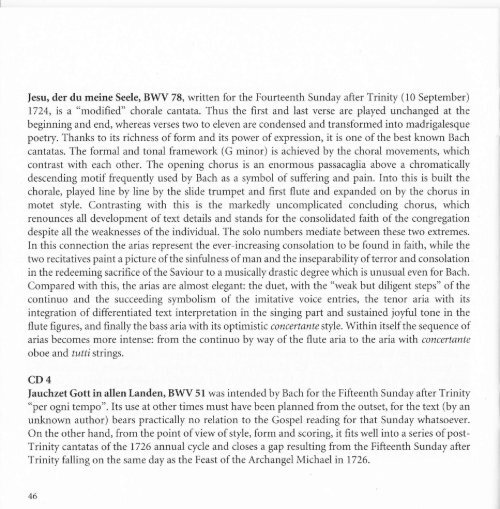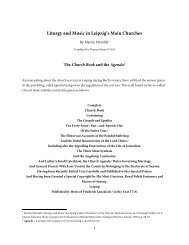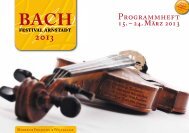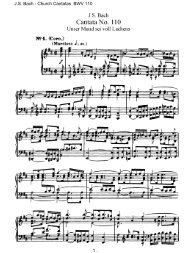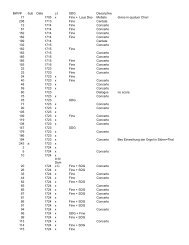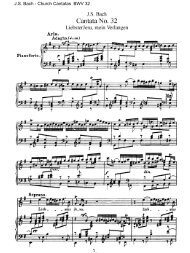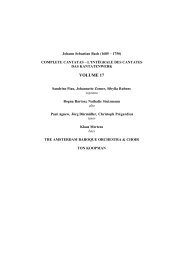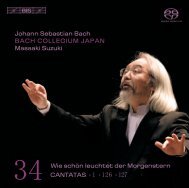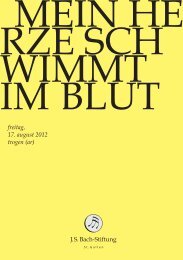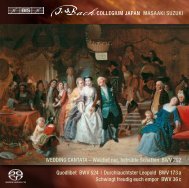Bach Cantatas, Vol. 2 - F. Werner (Erato 10-CD)
Bach Cantatas, Vol. 2 - F. Werner (Erato 10-CD)
Bach Cantatas, Vol. 2 - F. Werner (Erato 10-CD)
Create successful ePaper yourself
Turn your PDF publications into a flip-book with our unique Google optimized e-Paper software.
Jesu, der du meine Seele, BWV 78, written for the Fourteenth Sunday after Trinity ( <strong>10</strong> September)<br />
1724, is a "modified" chorale cantata. Thus the first and last verse are played unchanged at the<br />
beginning and end, whereas verses two to eleven are condensed and transformed into madrigalesque<br />
poetry. Thanks to its richness of form and its power of expression, it is one of the best known <strong>Bach</strong><br />
cantatas. The formal and tonal framework (G minor) is achieved by the choral movements, which<br />
contrast with each other. The opening chorus is an enormous passacaglia above a chromatically<br />
descending motif frequently used by <strong>Bach</strong> as a symbol of suffering and pain. Into this is built the<br />
chorale, played line by line by the slide trumpet and first flute and expanded on by the chorus in<br />
motet style. Contrasting with this is the markedly uncomplicated concluding chorus, which<br />
renounces all development of text details and stands for the consolidated faith of the congregation<br />
despite all the weaknesses of the individual. The solo numbers mediate between these two extremes.<br />
In this connection the arias represent the ever-increasing consolation to be found in faith, while the<br />
two recitatives paint a picture of the sinfulness of man and the inseparability of terror and consolation<br />
in the redeeming sacrifice of the Saviour to a musically drastic degree which is unusual even for <strong>Bach</strong>.<br />
Compared with this, the arias are almost elegant: the duet, with the "weak but diligent steps" of the<br />
continuo and the succeeding syrnbolism of the imitative voice entries, the tenor aria with its<br />
integration of differentiated text interpretation in the singing part and sustained joldrl tone in the<br />
flute figures, and finally the bass aria with its optimistic concertanteslyle. Within itself the sequence of<br />
arias becomes more intense: from the continuo by way of the flute aria to the aria with concertante<br />
oboe and tutti strings.<br />
<strong>CD</strong>4<br />
Jauchzet Gott in allen Landen, BWV 51 was intended by <strong>Bach</strong> for the Fifteenth Sunday after Trinity<br />
"per ogni tempo". Its use at other times must have been planned from the outset, for the text (by an<br />
unknown author) bears practically no relation to the Gospel reading for that Sunday whatsoever.<br />
On the other hand, from the point of view of style, form and scoring, it fits well into a series of post-<br />
Trinity cantatas ofthe 1726 annual cycle and closes a gap resulting from the Fifteenth Sunday after<br />
Trinity falling on the same day as the Feast of the Archangel Michael in 1726.<br />
46


